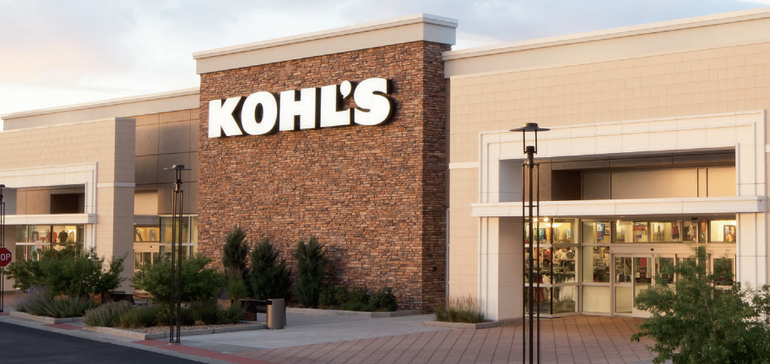Kohl’s has had an eventful year, yet not much has changed.
The department store in 2022 has been preoccupied with financial maneuverings strongly suggested by activist investors. Just last week Macellum Advisors issued yet another open letter to Kohl’s shareholders calling for further shakeup of the board — the board that last month was forced to formally back CEO Michelle Gass after another firm called for her removal.
Also this year, after months of forced contemplation of a sale or e-commerce spinoff, the chain declined a takeover offer from Vitamin Shoppe owner Franchise Group after deeming the bid too low. Some analysts said the company’s dawdling allowed for a lowered bid; in any case, weeks later Kohl’s was said to be considering a sale of some of its real estate.
A sale — whether of property or the entire enterprise — may please the investors interested in boosting the value of Kohl’s shares, but is unlikely to garner what the retailer really needs, according to some observers: a new identity.
“Kohl’s needs to occupy a clearer position in the minds of shoppers, and it needs to offer shoppers better experiences in-store and online,” Erik Gordon, professor at the University of Michigan’s Ross School of Business, said by email. “Who knows what Kohl’s is? Is it a lower-end Penney’s? Is it Target but with some name brands?”
What’s changed for Kohl’s
Kohl’s didn’t always have this problem. As a department store, the retailer for years successfully catered to a middle class customer, offering a mix of name brands and private labels in categories like apparel, home, jewelry and toys.
Now the department store sector is under siege. Middle-class households for years have struggled to keep up with the rising costs of major expenses like housing, healthcare and education while their incomes have stagnated. Meanwhile, the expansion of e-commerce and off-price retail has made it easier for consumers to find the discretionary items sold by the likes of Kohl’s — including the name brands it offers — at optimal prices.
“Who knows what Kohl’s is? Is it a lower-end Penney’s? Is it Target but with some name brands?”

Erik Gordon
Professor, University of Michigan’s Ross School of Business
“These middle-of-the-road department stores, they’re expensive, but then it’s not clear why the products are any better than at retailers like Target,” Colorado State University Business School Professor Jonathan Zhang said by phone. “Twenty years ago, you could get away with it because back then people didn’t have so much information, consumers were not as empowered. But now, in 2022, consumers can get products anywhere, so there’s a more experiential component to retail. And that’s where a lot of companies like Kohl’s and J.C. Penney might be lacking, because they don’t have the strong identity that is resonating with what consumers are looking for in terms of experience.”
Kohl’s location, mostly away from the mall in more convenient strip centers, remains a bit of an advantage, but not as much as it once did, and the company probably needs to shrink its footprint, Zhang also said.
But even those stores are too big, and Kohl’s location strategy hasn’t helped it escape the decline of the department store model, according to marketing consultant Brian Kelly.
“Relevance matters, and the breadth of relevance is no longer there,” Kelly said by email. “The number of stores has shrunk in response. How many more stores have to close? Maybe 400 stores will work? But then volume falls short because department stores are too expensive to operate profitably.”
What’s changed at Kohl’s
Kohl’s has made some strides recently, cleaning up its stores and adding Sephora shops to elevate its beauty offering, draw younger consumers and add $2 billion in sales by 2025. But it remains unexciting or even confusing to shop there, both in stores and online, according to Michigan’s Gordon.
Earlier this year, amid the distractions presented by some of its investors, Kohl’s outlined a vision predicated on transforming from a department store into a “focused lifestyle concept.” Key elements of the plan include its Sephora tie-up, the opening of 100 smaller stores and improvements to its women’s apparel business. Kirthi Kalyanam, professor of marketing and executive director of the Retail Management Institute at Santa Clara University’s Leavey School of Business, calls Kohl’s efforts “very much a work in progress,” with an obscure endgame.
“I’m not saying that they haven’t moved forward in this direction,” he said by phone. “But I don’t think that they’ve convincingly made a case for — what’s the transformation they’re going through? And what does the other side look like?”
What Kohl’s must change
Since 2017, Kohl’s has lost share among younger consumers between 25 and 34 years old and those older than 55, though it has captured share among older millennials aged 35 to 44, according to recent research from Cowen & Co.
The company’s Sephora expansion — there will be a shop in some 850 Kohl’s stores some time next year, and in all of them eventually — and its private labels could help boost its share, those analysts said.
“The near-term catalyst for [Kohl’s] remains the expansion of Sephora stores, which continue to outperform the rest of the portfolio by high-single digits for the stores opened last year and mid-single digits for the stores opened this year,” wrote the Cowen team led by John Kernan. “Further, [Kohl’s] is entering a pivotal time for the private brands portfolio as core customers shop for value, specifically in the kid’s section, which could continue to drive traffic for the millennial or new parent cohort.”
Better sales of private labels could benefit gross margins as Kohl’s faces ongoing pressure to clear inventory and cut prices, according to Cowen.
Cutting its SKU count, revamping its private labels, offering more exclusive labels and redesigning stores may be necessary for any turnaround at Kohl’s, just as it was at Target, experts say. And Kohl’s seems to agree, as it’s stepped up such efforts in recent years. But success takes time, money and a strong identity, Zhang said.
“There’s no magic way to save retail, and from a time perspective there’s no such thing as a quick fix,” he said. “When you look at Kohl’s, what’s unique? You don’t have a unique store experience, you don’t have the unique inventory. So then, what’s your story? What’s so compelling about going into a shop or Kohl’s dot com? It’s not clear.”
Kaarin Vembar contributed reporting to this story.

